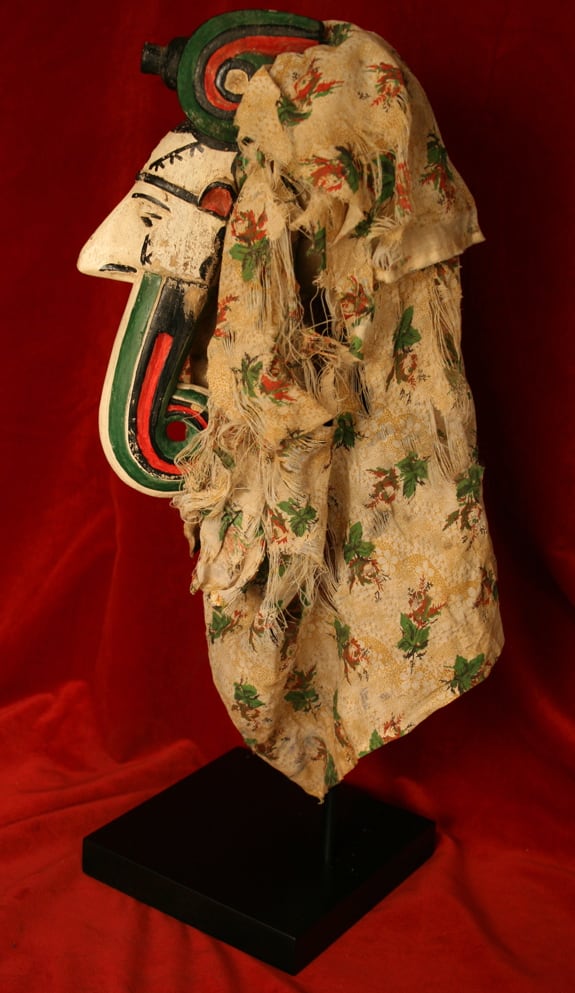Baga Colonial Period Polychrome Banda Mask, 20th Century CE
Wood, Paint, Cloth
PF.8019 (LSO)
This striking polychrome mask and hood were made by the Baga people of Coastal Guinea. One might be excused for assigning it a Far-Eastern origin. The long, thin face is...
This striking polychrome mask and hood were made by the Baga people of Coastal Guinea. One might be excused for assigning it a Far-Eastern origin. The long, thin face is brightly coloured with a range of pigments against a glossy white background. The hair is rendered as a complex block of black-painted geometric shapes. The mouth is extended into a long beak-like prominence, while the downward-pointing black eyes and the slender nose are tiny by comparison. The cheeks and forehead are marked with further geometric patterns as decoration. The hood appears to be made of colonial period western cloth with a very fine weave and a floral pattern. The entire piece is clearly only traditional insofar as it was made by local craftsmen and retains some general Baga tendencies in the skewing of facial features. It was designed to take advantage of imported materials, notably paint, and was probably used in a masquerade performance like more conventional Banda masks.
The Baga live on the Coast of Guinea, and are named for the phrase bae-raka: People of the Seaside. They speak their own language and also the Mande language, Susu. The Baga are one of several groups of coastal Guinea Bissau, and live in village environments traditionally ruled over by clan heads. Their economy is based upon rice agriculture and fishing; the latter may have been secondarily learned as oral tradition states that the Baga people migrated from inland areas towards the sea by a hostile invasion of their homelands.
They originally believed in a deity named Kanu, who controlled male (Somtup) and female (A-Bol) spirits, as well as a snake spirit called A-Mantsho-nga-Tshol. Their traditional religion was forced out by the arrival of Islam in the mid 20th century, leading to a plethora of art objects arriving in western markets. Perhaps the best-known is the large four-legged Nimba mask, which is associated with fertility of both crops and women; figures, drums and head-crests are also known, but are very rare. They also made impressive caryatid stools, which were considered to be prestige objects and were used by elders during secret meetings.
The precise role of this piece is uncertain, as stated, but the painting and cloth both indicate a comparatively late date. There is little published data about the Baga in the colonial period, although it seems possible that religious iconography was abandoned (as stated above) while more harmless entertainment-based items did not suffer excoriation at the hands of recently converted Islamists. Banda masks are usually rather larger than this, and zoomorphic, although the full range of variability is currently poorly understood.
Whatever its rationale, however, it does not detract from what is a boldly graphic and impressively decorated piece of African art.
The Baga live on the Coast of Guinea, and are named for the phrase bae-raka: People of the Seaside. They speak their own language and also the Mande language, Susu. The Baga are one of several groups of coastal Guinea Bissau, and live in village environments traditionally ruled over by clan heads. Their economy is based upon rice agriculture and fishing; the latter may have been secondarily learned as oral tradition states that the Baga people migrated from inland areas towards the sea by a hostile invasion of their homelands.
They originally believed in a deity named Kanu, who controlled male (Somtup) and female (A-Bol) spirits, as well as a snake spirit called A-Mantsho-nga-Tshol. Their traditional religion was forced out by the arrival of Islam in the mid 20th century, leading to a plethora of art objects arriving in western markets. Perhaps the best-known is the large four-legged Nimba mask, which is associated with fertility of both crops and women; figures, drums and head-crests are also known, but are very rare. They also made impressive caryatid stools, which were considered to be prestige objects and were used by elders during secret meetings.
The precise role of this piece is uncertain, as stated, but the painting and cloth both indicate a comparatively late date. There is little published data about the Baga in the colonial period, although it seems possible that religious iconography was abandoned (as stated above) while more harmless entertainment-based items did not suffer excoriation at the hands of recently converted Islamists. Banda masks are usually rather larger than this, and zoomorphic, although the full range of variability is currently poorly understood.
Whatever its rationale, however, it does not detract from what is a boldly graphic and impressively decorated piece of African art.



